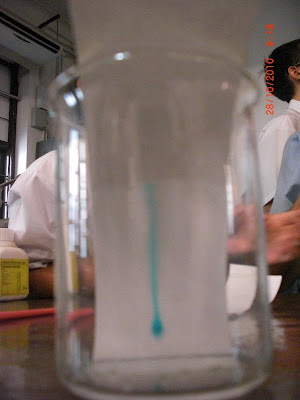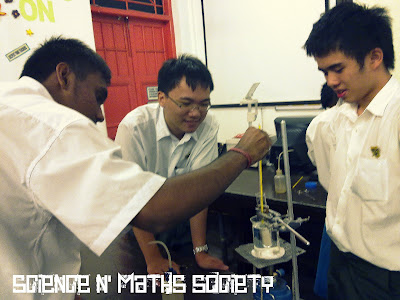this week we had 2 events going on!
Sweet's chromatography and burning money!
Basically in the former we'll have to have some dyed sweets available, in this case, we were using M&M's, filter papers, alcoholic solvents... and the latter we need some alcohol (diluted with water at the ratio of alcohol:water = 1:1), a money bill you think it's worth scientific sacrificial value.. and perhaps, something that produces fire, which eventually burns...
Chromatography of chlorophyll may seem normal, and sometimes time-consuming (depending on skills), and troublesome if the availability of drying facilities is LOW.. whereas chromatography of sweets is just simple enough because essentially we don't need that concentrated dye(s) like chlorophyll.. The capillary action of the solvent touching the filter paper, dotted with a particular dye, enables observers to watch which different colors are composed of manufacturing one single color of the M&M's you eat, within a line of visible color spectrum.
While this chromatography takes time right after you are done with the dot-and-dry troubles and finally leave it alone in the beaker with diluted alcohol as solvent, you shall feel so bored that you will need something else to wake up. Right then, it's time to burn some valuables!
Well, what you need here is SIMPLE... Since we're conducting this in a laboratory, things are easy. A bunsen burner will be essential if you are reluctant of plucking your thumb on the click of a household lighter.. A money bill, the larger denomination the better.. A pair of tongs, not if you are not prone to three-degree burn and scald.. a big container with alcohol water (perhaps ethanol water) with the proportion of water to alcohol, 1:1, where it should be noted that the alcohol is as concentrated as 95-99% before dilution, and finally some salts..
Alright, salts are used to produce VISIBLE flame, where a small amount would suffice. NaCl would produce a typical yellow-red flame. KCl would produce a mild purple one.. Not sure if they are wrong, lol. Fantastic flame can be produced by adding potassium permanganate.
The steps are easier than gathering things you need for this. First, soak your money bill in the solution you've prepared earlier, what I mean here is, SOAK entirely. There's a little precaution here.. make sure you use the thongs, and not a drop of alcohol is in contact with your skin! Finally lit up the bill (stay away from the container filled with alcohol solution), and sit and watch the magic =D
The theory of burning money without having the fire consuming your bill for your lunch is simple. Basically the alcohol burns with a lower temperature than water itself does. This is the trick: when alcohol burns, the heat of the flame is just insufficient to overcome the specific heat capacity of the water, and thus the water acts as a protective barrier which prevents you from starving the whole afternoon!
Well the below's some demonstration we've done during the last Thursday... blah..blah..









































